The road to success and the road to failure are almost exactly the same.
After returning to the English Premier League in 2019, Aston Villa’s ambition increased cumulatively over time, as the owners—NSWE group—pumped substantial investments in the team since that.
On November 1, 2022, Unai Emery became Aston Villa’s head coach, succeeding both Dean Smith and Steven Gerrard; the team had signed numerous promising player signings.
The Villains’ aspirations soared after a terrific performance by Emery in the previous season. However, the current season has seen the team achieve a balanced record of winning half of their matches while losing the other half. They scored eight goals but conceded nine in just four games.
In a previous analysis, we examined Aston Villa’s attacking tactics under Unai Emery. However, the team has faced recurring defensive issues since last season, which have persisted into this season.
This tactical analysis will explore whether these issues stem from the players’ quality or Emery’s tactical choices and defensive strategies.
At the end of last season, Emery primarily relied on an exciting 6-2-2 low-block defensively. However, in most of the four matches played this season, he has tended more to a 4-4-2 compact mid-block, positioning players closely together. , as in below against Liverpool in the last match, which ended in a 3-0 loss.

Briefly about mid-block compactness
“Defending is a matter of ‘How much space should I defend? Everything is about meters, that’s all” — Johan Cruyff.
Compactness in defence entails maintaining short distances between players both horizontally and vertically. At the same time, a typical mid-block spacing between every two lines is approximately 20 meters. In the compact form implemented by Aston Villa, the distance is only 10 metres. The graphic below illustrates this concept along the X-axis and Y-axis.

Cruyff’s idea revolves around creating a smaller defensive space, bringing players closer together. These reduced distances between teammates make it challenging for opponents to execute penetrative passes as passing lanes become restricted.
Many teams today position their players between the lines to receive passes behind the midfield, exposing the backlines to vulnerable situations. However, the proximity between these lines eradicates this space, preventing opponents from gaining positional advantages and compelling them to circulate possession to less strategically valuable areas.
Typically, this compact structure forces opposing teams to explore alternative strategies, such as resorting to long balls and other tactics. When employed in the middle third of the pitch, it implies playing with a high defensive line, necessitating a skilled sweeper-keeper and a quick, intelligent backline capable of handling running situations and executing offside traps effectively.
Timing and pace when maintaining a high line—leaving space between the defensive line and the goalkeeper, making it vulnerable to long through balls and opposition runners breaking behind the defence—are everything.
Having defenders and goalkeepers well-suited to the system is essential to execute this approach effectively. The question then arises: Does Unai Emery possess such players on his roster at Aston Villa?
Aston Villa’s compact mid-block
Since the start of the season, there have been evident weaknesses in Aston Villa‘s high-pressing phase. These issues primarily involve scheme issues, player timing, attitudes, and reactions related to marking and screening, resulting in gaps that expose the team to penetration through the scheme or long balls behind the high defensive line.
To illustrate, let’s compare Aston Villa’s high regains (pressing moments) with Brighton, a team of similar calibre in the Premier League. Brighton has achieved 66 high regains in their first four matches, whereas Villa has managed less than half of that, with only 23 high regains.

Due to these pressing issues, Villa often finds itself forced to retreat. Unai Emery typically employs a passive 4-4-2 compact mid-block, but specific problems arise within this setup.
Breakthrough
One significant issue, which also affects the high-pressing phase, is the inconsistency in pressing, tracking, and maintaining a compact structure on the team’s left side compared to the right side, where players are somewhat more effective.
For instance, in Liverpool’s match, Villa adhered to their passive mid-block. Curtis Jones and Luis Díaz stuck on the left side (which is the right side from Aston Villa’s perspective) in front of Matty Cash and Ezri Konsa. Moussa Diaby tracked Liverpool’s Mac Allister while Boubacar Kamara instructed to cover the vacating half-spaces.
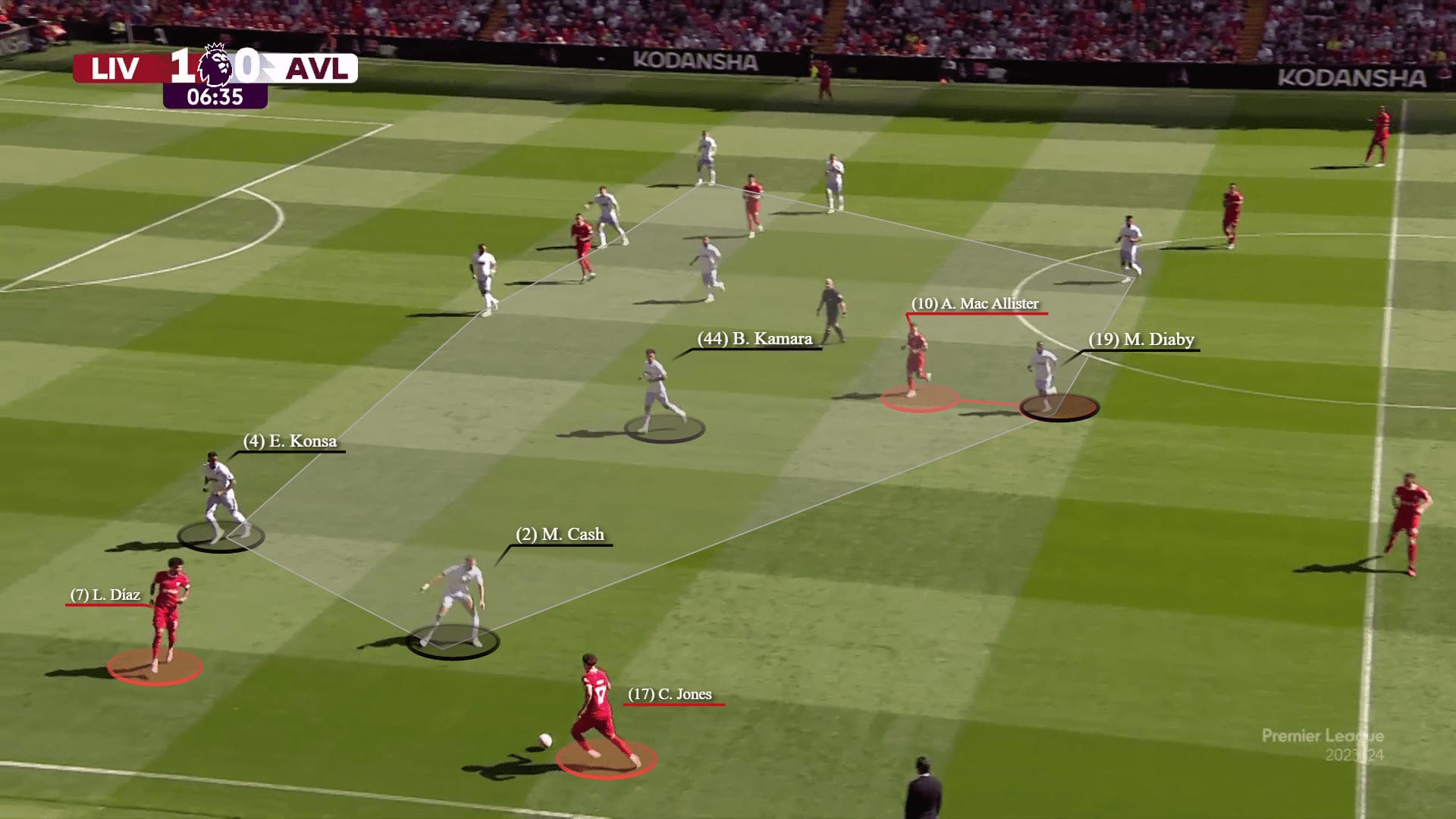
After aggressive pressure and commitment, and Diaby dropping to screen the midfielder (blocking the pass), Jones was pushed back to Andrew Robertson, who changed the attack starting point to the other side, towards the inverted full-back Trent Alexander-Arnold.

The latter passed easily in front of weak tracking and poor screening from Ollie Watkins to close the passing path towards Dominik Szoboszlai. Douglas Luiz arrived a bit late as the latter passed it to Joël Matip in the side.

Szoboszlai then moved higher into half-space under good following from Douglas Luiz, meanwhile, while Trent quickly advanced with Watkins struggling to track him. Before that, Mohamed Salah had tricked Lucas Digne with a double movement and dropped to receive from Matip.
Salah played to Trent, who positioned in between lines and played it behind the last line to the third-man Szoboszlai, putting Aston Villa in a problematic situation.

In the same match, a few minutes later, there was a penetration above Aston Villa’s defensive block due to inadequate screening and monitoring by Ollie Watkins and Douglas Luiz, respectively. At the same time, Diaby remained fully committed.

As a result, Arnold, who is currently one of Liverpool’s most dangerous playmakers, had the time and space to execute a long diagonal switch. This pass isolated Luis Díaz in a 1v1 situation with Ezri Konsa and created a 3v3 situation over the Villa backline, putting the defence in a challenging predicament.


Against this high line, does Emery have the proper defenders? How can manipulation also be possible?
Unai Emery’s reliance on this defensive approach with a slightly high defensive line that is constantly exposed to long balls in behind raises questions about whether Aston Villa possesses an effective, flexible, and pacey backline to cope with this strategy. Specifically, are centre-backs like Tyrone Mings and Pau Torres who might be well-suited for this shape?
It can be argued that Diago Carlos, thanks to his flexibility, acceleration, pace, and agility in changing direction rapidly, stands out as the most suitable centre-back for this system within the team. Following him, Ezri Konsa also offers valuable attributes.
However, Pau Torres, despite his influence in the build-up phase, is relatively slower and has difficulty with quick changes of direction, somewhat resembling Harry Maguire. Similarly, Tyrone Mings and the new signing Lenglet. They excel more in low-block systems rather than these approaches that require a quick change of direction, acceleration, and intuitive speed.
Moreover, on both sides, while Matty Cash and Lucas Digne may not possess an abundance of defensive positioning capabilities and influence, they do bring enough speed to facilitate reverse covering, effectively protecting the entire backline.
Manipulation
In the context of Aston Villa’s passivity and compactness, consequently, a high line applied, opposing teams often employ various tactics for manipulation and gain dynamic superiority of strikers over the defenders before launching a ball into space and initiating a run.
Here next, against Liverpool in the second goal, Trent was given comfort to receive and pass between Liverpool’s first and second lines. The back pass always provokes the defence line to move forward more.
Lucas Digne was positioned close to Mohamed Salah on the left, which created a gap in the left half-space that Darwin Núñez could exploit.
To mitigate these gaps, Aston Villa’s wingers would occasionally drop back to form a 6-2-2. This was exemplified on the opposite side, where Leon Bailey dropped back, prompting Matty Cash to shift inward and closely mark Diaz.
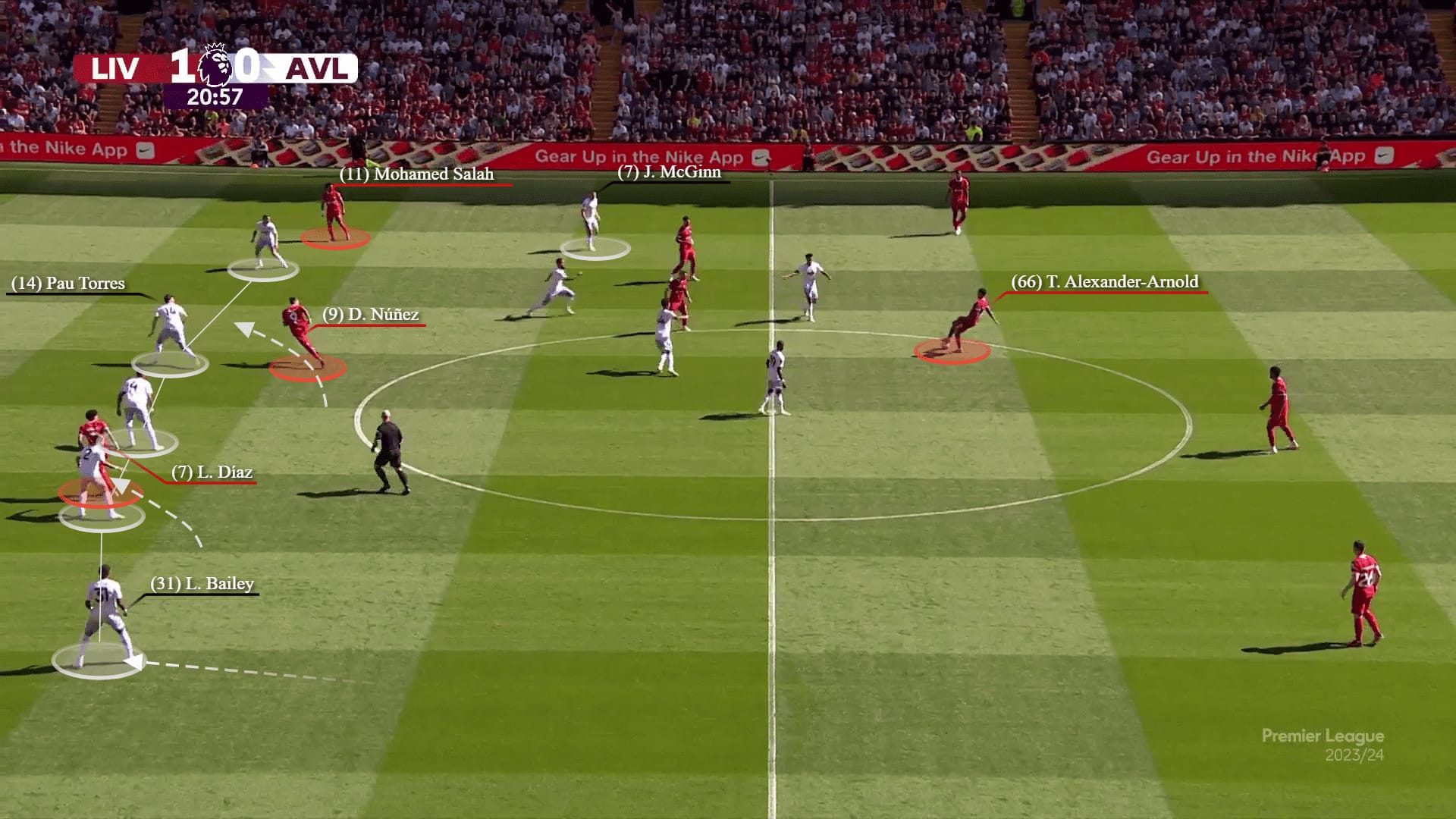
During this sequence, Arnold tested the defenders by a feint (rolling the ball) and feigning a long pass for Núñez, which induced Pau Torres and Lucas Digne to track potential runs from Núñez and Salah.
Mentally, defenders usually calm down again momentarily, and the confusion resulting from these sporadic and unpredictable movements can disperse the effectiveness of an offside trap.
In this instance, Arnold swiftly played a long ball to Salah, who gained the dynamic advantage over Digne. In contrast, Núñez had gained several meters on Torres due to the previous movement and relative slowness.
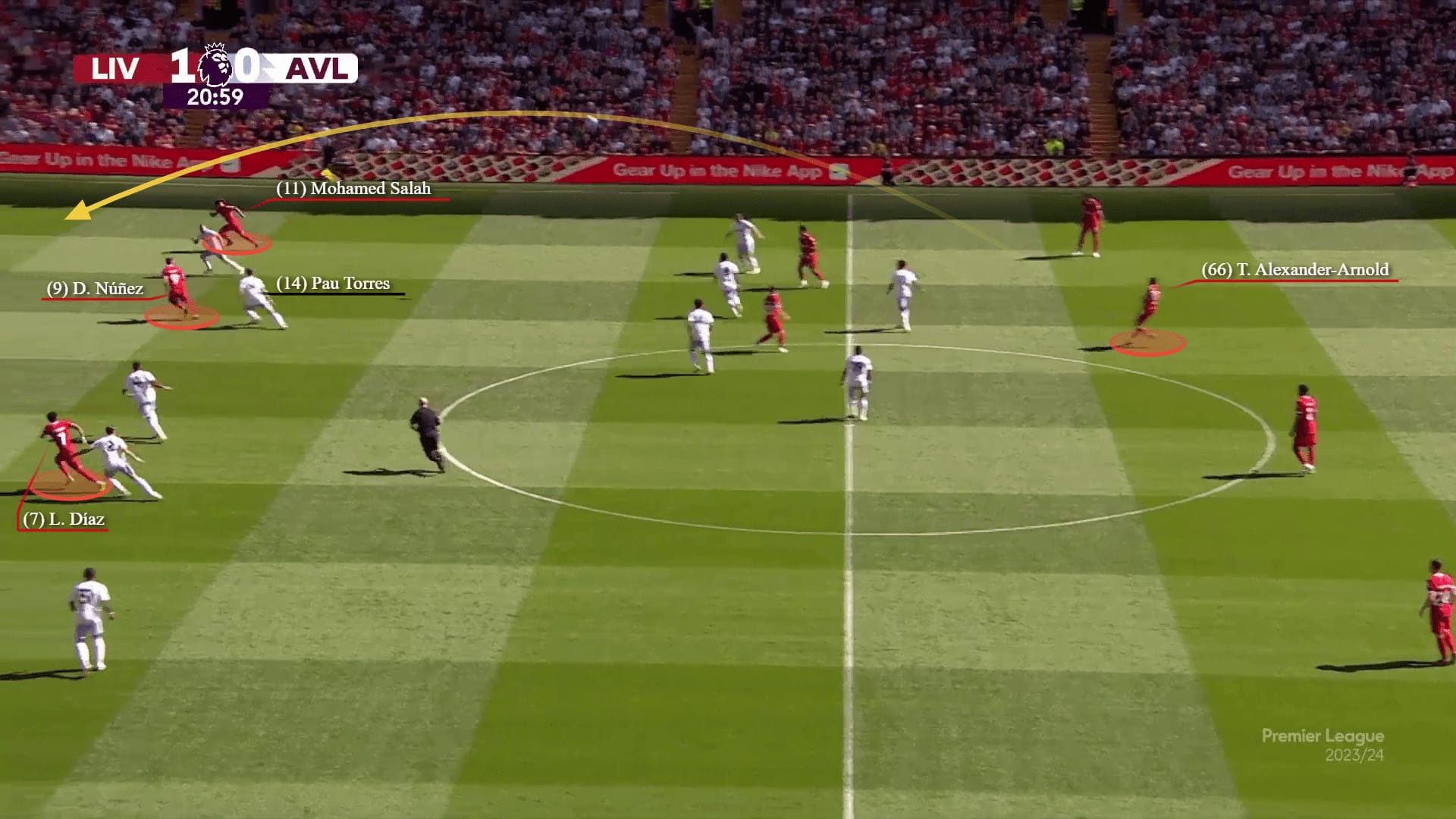
The play concluded with an own goal by Matty Cash, who attempted to cover the defence but missed the ball after Núñez’s shot hit the crossbar.
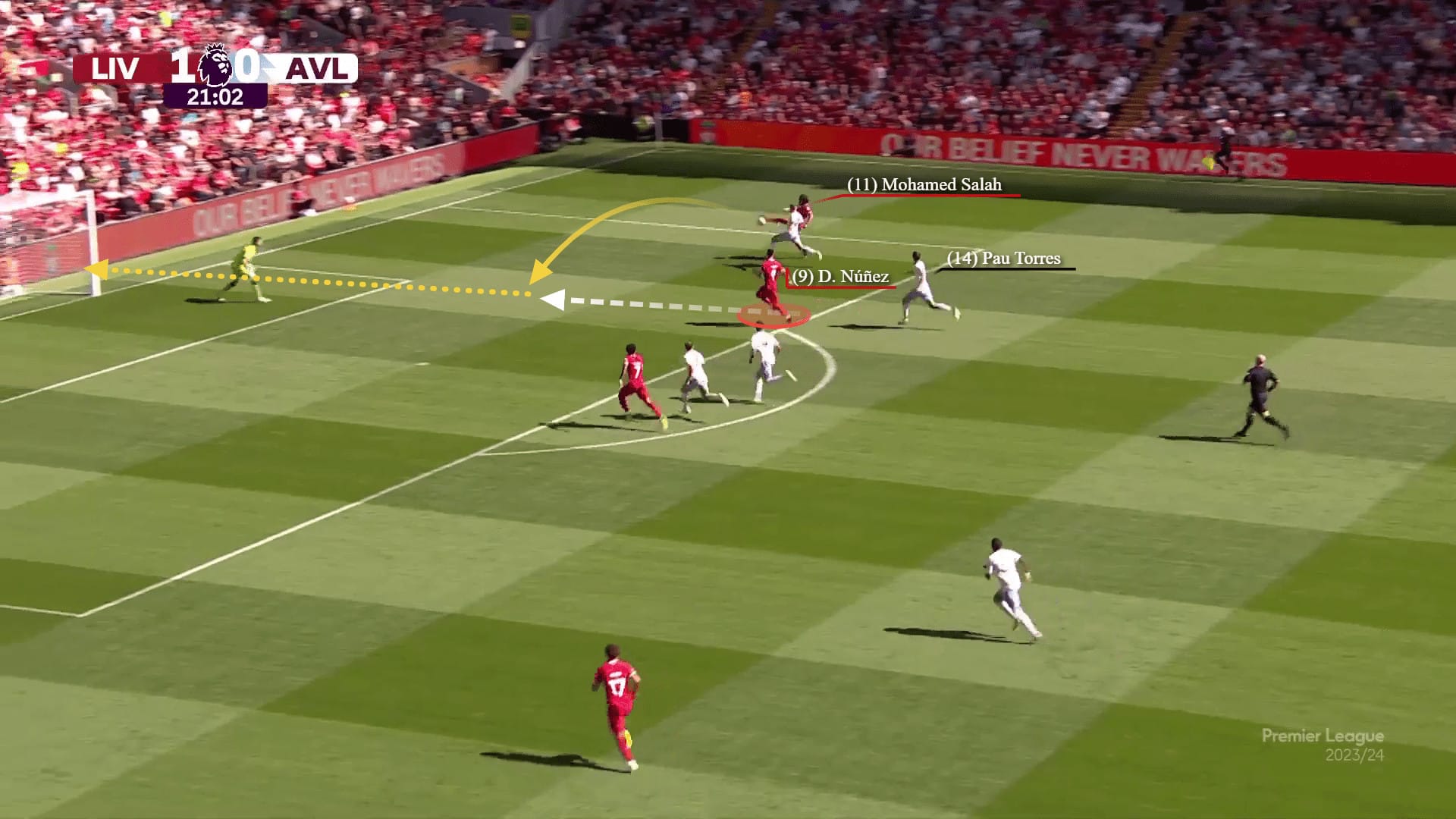
The transition and movement of the wingers to the last line appear to be more intermittent this season compared to the previous one.
In the game match against Burnley, there was an overloading where three attackers positioned themselves against the two centre-backs, while the full-backs were attention on Burnley’s wingers.
Had the wingers descended dynamically and taken up deeper positions within the last defensive line, the team could have avoided outnumbering the centre-backs.
In this specific situation, Burnley’s player squandered the ball by failing to control it, and Pau Torres subsequently cleared it to avert the threat.
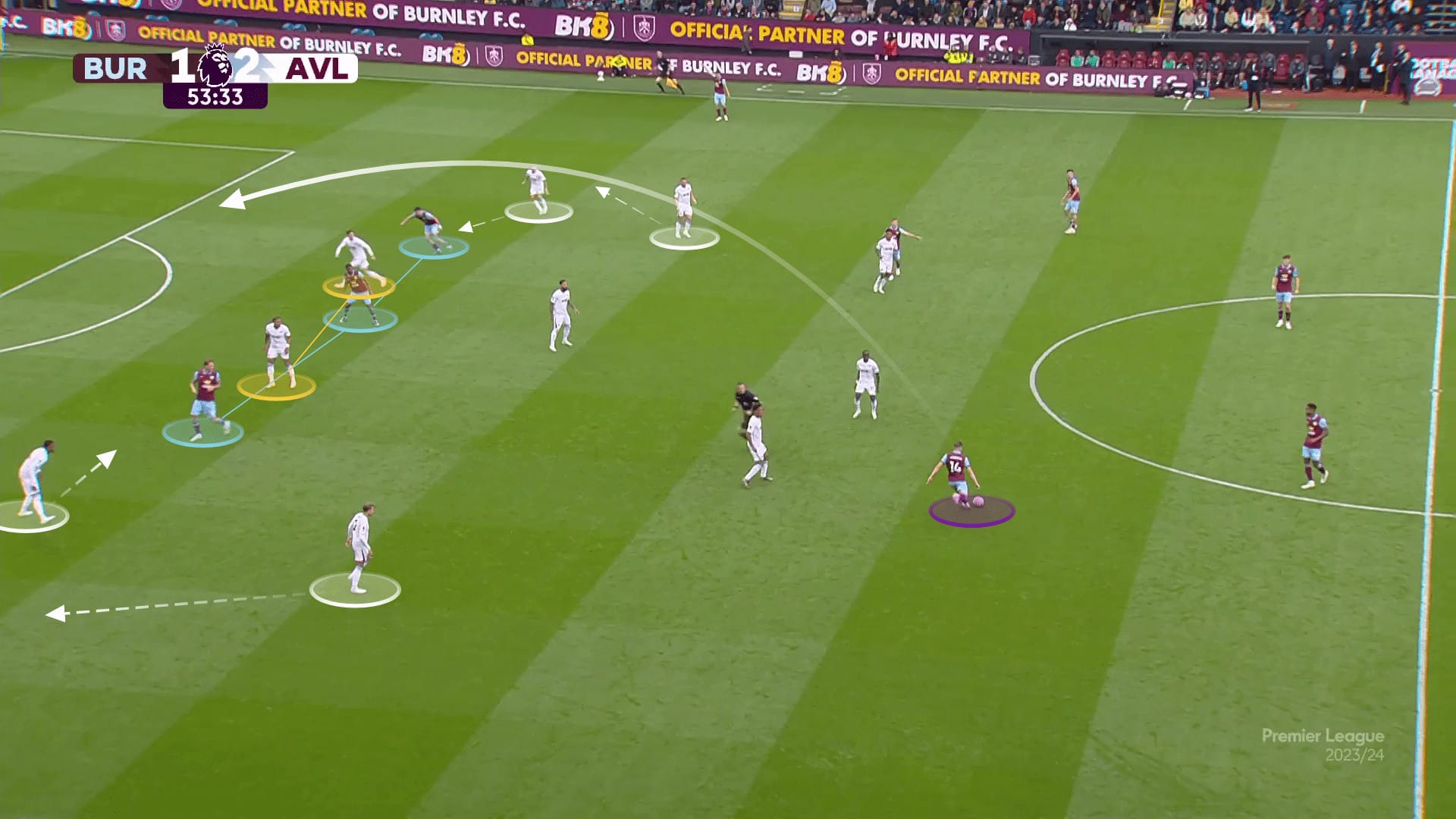
Sweeper-keeper
To execute the high line and leave space behind, a goalkeeper is required who positions himself higher up the pitch. This goalkeeper should be able to read the game effectively, enabling proactive decision-making, efficient ball distribution, and the selection of perfectly timed moments to engage in play.
Since last season, the World Cup champion Emiliano Martínez has demonstrated a commendable rate of exits and clearances, though not the absolute best in this regard.
However, there have been instances of mistakes, such as the one he made in the team’s 5-1 loss against Newcastle. In this match, he ventured out after a long ball played behind by Fabian Schär to Joelinton, who initiated a diagonal run.
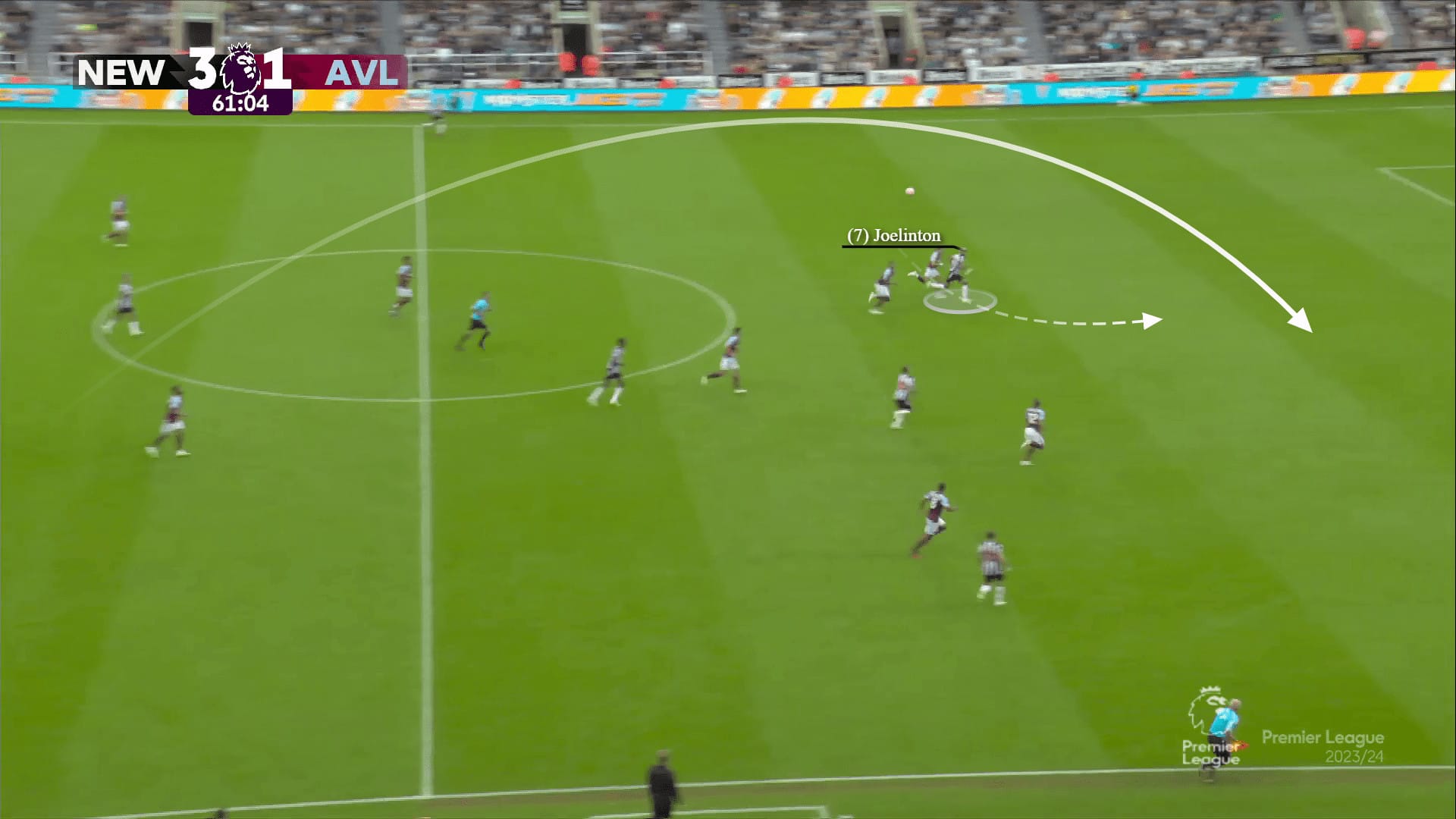
Unfortunately, Emiliano Martínez’s clearance went awry, pushing the ball to the right, where Almiron quickly reached it and took a shot, but Emiliano managed to retain control of the ball.

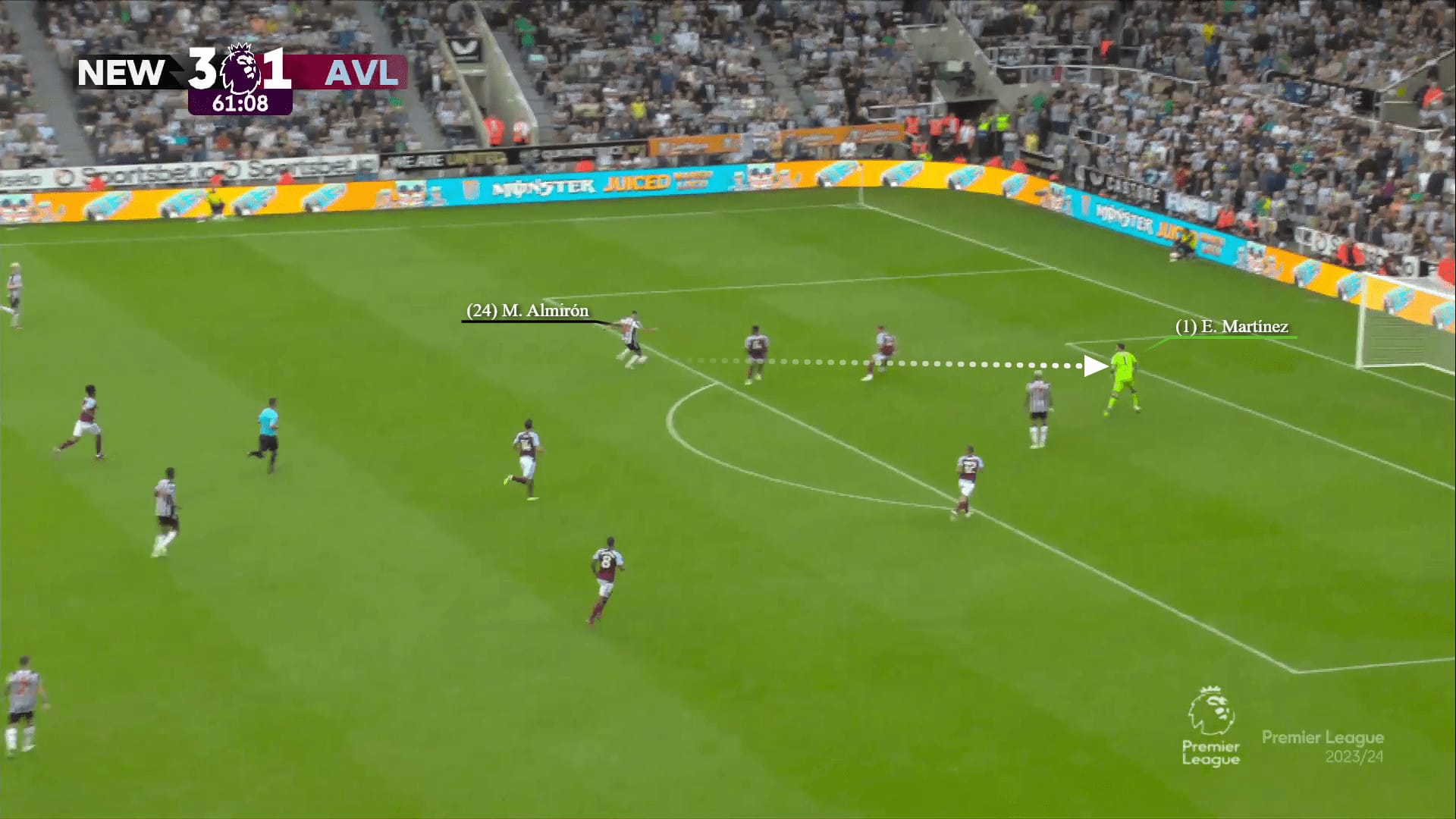
Conclusion
In conclusion of this scout report, Aston Villa’s journey under Unai Emery has been marked by both promise and challenges. While Emery has used a compact mid-block, defensive vulnerabilities have persisted.
The effectiveness of this strategy has raised questions about the suitability of certain players for the system, particularly in defence.
Aston Villa’s road to success and the road to failure seem to run parallel, with both promise and obstacles along the way.
With these signings, Aston Villa could potentially aim for a spot in the UEFA Europa League in the upcoming season.





Comments